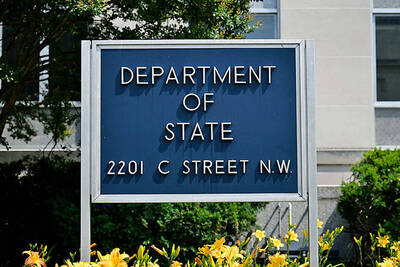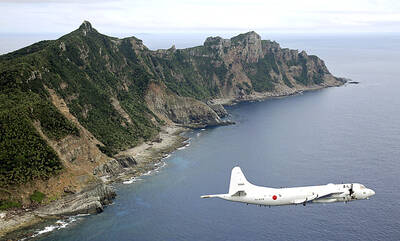Former Singaporean prime minister Lee Kuan Yew (李光耀) said Chinese President Hu Jintao (胡錦濤) appeared “patient” in moving toward the goal of bringing Taiwan into the Chinese fold, an approach that was deemed a success by Chinese academics, leaked US cables showed.
Several US diplomatic cables released by WikiLeaks showed that Taiwan was among the issues discussed when then-US deputy secretary of state James Steinberg and US Senator Bill Nelson met separately with Lee in 2009.
A cable dated June 4, 2009, from the US embassy in Singapore detailed Lee telling Steinberg that Hu could live with President Ma Ying-jeou’s (馬英九) position on the so-called “1992 consensus” and on not addressing the “reunification issue” during his term in office, because Hu was “more patient and does not have any fixed timeline.”
Lee was quoted in the cable as saying former Chinese president Jiang Zemin (江澤民) was “wedded” to his eight-point approach, while Hu was more flexible. Jiang wanted to show he was a great man by solving the “Taiwan issue” in his lifetime, but Hu was more patient, Lee added.
“On Taiwan, Hu will be pragmatic. It does not matter to Hu if it takes 10 years or 20 or 30. The key is building links with Taiwan,” Lee was quoted as saying.
“What mattered to Hu was that Taiwan not seek independence. If that happened, China has 1,000 missiles and is building its capacity to hold the US fleet at a distance. The implicit question for Taiwan’s leaders is if that is what they want,” Lee added.
Beijing’s calculations appeared to be to prevent Taiwanese independence in the near term, “then bring Taiwan ‘back to China,’ even if it takes 40 or 50 years,” the cable showed Lee as saying.
Lee also said Hu had wanted Chinese Vice Premier Li Keqiang (李克強) to be his successor, not Chinese Vice President Xi Jinping (習近平), “but Hu did his calculations and accepted Xi when it became clear that Xi had the necessary backing from the rest of the leadership,” also an example indicating Hu was “pragmatic.”
In another cable from the same embassy, dated Aug. 17, 2009, Lee, in a meeting on Aug, 13, 2009, with Nelson, said China had asked Singapore to stop sending its troops for training in Taiwan and offered training areas in China’s Hainan instead.
Singapore does not have official diplomatic ties with Taiwan, but an agreement that began in 1975 allowed Singapore to train infantry, artillery, armored and commando units in Taiwan.
The cable showed Lee as telling his Chinese counterparts that “if Singapore forces go to Hainan for training, the Americans will stop selling Singapore arms.”
“[Lee] intended for the Chinese to get the message that their arms are not equal to American arms, he said. He added that he has told Beijing that if Beijing is in charge of Taiwan, he will ask Beijing for permission to train there,” the cable said.
Singapore is still pressured by Beijing on issues like Taiwan, Lee said.
Another cable, dated April 30, 2008, from the US embassy in Beijing showed that some Chinese academics exchanged views about Hu’s “patient” attitude on the “Taiwan issue” and considered the strategy a success in terms of increasing China’s influence on Taiwan.
Guo Zhenyuan (郭震遠), a senior academic at the China Institute of International Studies, said Hu “took risks” when he met with then-honorary Chinese Nationalist Party (KMT) chairman Lien Chan (連戰) in 2005, expressing his faith in Taiwanese people in his “four nevers” speech, broke from Jiang’s timeline for unification, and deciding to be “very restrained” in the lead-up to the presidential election and referendum vote in March 2008, the cable showed.
“If the Taiwan referenda on joining the United Nations had passed and the DPP [Democratic Progressive Party] had stayed in power, Hu would have been vulnerable to strong attacks against his policy. By contrast, having achieved ‘the best possible result in the elections’ [that the KMT won the election and the referendums were defeated], Hu is now ‘very strong’ on Taiwan Policy, Guo argued,” the cable read.
The cable quoted Yang Liuchang, director-general of the Hong Kong, Macao, and Overseas Affairs Division of Beijing’s Taiwan Affairs Office, as saying that Hu’s policy had been successful because it focused on peaceful development, which was a “win-win” situation for people on both sides of the Taiwan Strait.
“Yang said Hu is serious about achieving a peace agreement but will be patient and, unlike Jiang Zemin, will ‘not rush’ in pushing forward on cross-Strait issues,” Yang said.
In its comment, the US embassy in Beijing said it was a fact that Hu’s successful strategic gambles appeared to have strengthened his hand on Taiwan, the cable read.

MISINFORMATION: The generated content tends to adopt China’s official stance, such as ‘Taiwan is currently governed by the Chinese central government,’ the NSB said Five China-developed artificial intelligence (AI) language models exhibit cybersecurity risks and content biases, an inspection conducted by the National Security Bureau (NSB) showed. The five AI tools are: DeepSeek, Doubao (豆包), Yiyan (文心一言), Tongyi (通義千問) and Yuanbao (騰訊元寶), the bureau said, advising people to remain vigilant to protect personal data privacy and corporate business secrets. The NSB said it, in accordance with the National Intelligence Services Act (國家情報工作法), has reviewed international cybersecurity reports and intelligence, and coordinated with the Ministry of Justice Investigation Bureau and the National Police Agency’s Criminal Investigation Bureau to conduct an inspection of China-made AI language

BOOST IN CONFIDENCE: The sale sends a clear message of support for Taiwan and dispels rumors that US President Donald Trump ‘sold out’ the nation, an expert said The US government on Thursday announced a possible sale to Taiwan of fighter jet parts, which was estimated to cost about US$330 million, in a move that an expert said “sends a clear message of support for Taiwan” amid fears that Washington might be wavering in its attitude toward Taipei. It was the first announcement of an arms sale to Taiwan since US President Donald Trump returned to the White House earlier this year. The proposed package includes non-standard components, spare and repair parts, consumables and accessories, as well repair and return support for the F-16, C-130 and Indigenous Defense Fighter aircraft,

CHECKING BOUNDARIES: China wants to disrupt solidarity among democracies and test their red lines, but it is instead pushing nations to become more united, an expert said The US Department of State on Friday expressed deep concern over a Chinese public security agency’s investigation into Legislator Puma Shen (沈伯洋) for “secession.” “China’s actions threaten free speech and erode norms that have underpinned the cross-strait ‘status quo’ for decades,” a US Department of State spokesperson said. The Chongqing Municipal Public Security Bureau late last month listed Shen as “wanted” and launched an investigation into alleged “secession-related” criminal activities, including his founding of the Kuma Academy, a civil defense organization that prepares people for an invasion by China. The spokesperson said that the US was “deeply concerned” about the bureau investigating Shen

DISPUTE: A Chinese official prompted a formal protest from Tokyo by saying that ‘the dirty head that sticks itself out must be cut off,’ after Takaichi’s Taiwan remarks Four armed China Coast Guard vessels yesterday morning sailed through disputed waters controlled by Japan, amid a diplomatic spat following Japanese Prime Minister Sanae Takaichi’s comments on Taiwan. The four ships sailed around the Senkaku Islands — known as the Diaoyutai Islands (釣魚台) to Taiwan, and which Taiwan and China also claim — on Saturday before entering Japanese waters yesterday and left, the Japan Coast Guard said. The China Coast Guard said in a statement that it carried out a “rights enforcement patrol” through the waters and that it was a lawful operation. As of the end of last month,